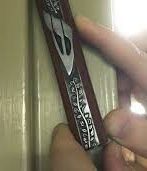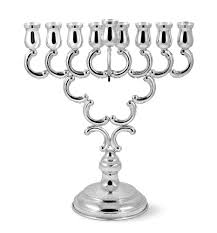Chanukah: the Holiness of the Doorway – the Mezuzah and the Chanukiya
 There is a curious connection between the mezuzah and the lighting of the chanukiya. These two mitzvot are brought together in halakhic, midrashic and mystical material. I would like to present two foundational texts that help prepare us for a new and exciting approach to Chanukah.
There is a curious connection between the mezuzah and the lighting of the chanukiya. These two mitzvot are brought together in halakhic, midrashic and mystical material. I would like to present two foundational texts that help prepare us for a new and exciting approach to Chanukah.
The Bavli
First, the gemara in Shabbat 22a, in describing where exactly to place the Chanukah lights, tells us that there is a mitzvah to place the chanukiya within a tefach (a hand’s breadth) of the doorway1. We then learn this debate:
שבת כ”ב.
וְהֵיכָא מַנַּח לֵיהּ?
רַב אַחָא בְּרֵיהּ דְּרָבָא אָמַר מִיָּמִין
רַב שְׁמוּאֵל מִדִּפְתִּי אָמַר מִשְּׂמֹאל.
Bavli Shabbat 22a
And where [near the doorway] should it be placed?
Rav Acha the son of Rava said, “On the right.”
Rav Shmuel from Difti said, “On the left.”
There is very little additional information offered in the sugya as to why each Amora held his position2. In the sheiltot of Rav Achai (first half of the 8th century), we find an early commentary on this debate, which tries to explain both approaches:
שאילתות דרב אחאי גאון כ”ו
מאן דאמר מימין קא סבר כי היכי דלהוי תרתי מצוותא בחד דוכתא נר חנוכה ומזוזה. ומאן דאמר משמאל קא סבר כי היכי דלהוי מזוזה מימין ונר חנוכה משמאל ובעל הבית בטלית מצוייצת ביניהן.
Sheiltot d’Rav Achai Gaon 26
The one who says that it goes on the right thinks that we should do two Mitzvot in one place: the lights of Chanukah and the mezuzah. And the one who says that it should go on the left thinks that we should have the mezuzah on the right, the lights of Chanukah on the left and the master of the house wearing his talit with tzitzit among them [the mitzvot].
There is something awkward about the assumption that someone would be wearing a talit while the Chanukah lights are burning as these rituals don’t happen at the same time of day. This incongruity is addressed by the Netziv in his commentary on the sheiltot3 where he tries to push candle lighting earlier or claim that talit was worn later. For now, I simply want to note the confluence of all these mitzvot into one moment: mezuzah, chanukiya, talit, tefillin.
The gemara itself decides the debate regarding at which side of the doorway to light and paskens in the very next line:
וְהִילְכְתָא מִשְּׂמֹאל כְּדֵי שֶׁתְּהֵא נֵר חֲנוּכָּה מִשְּׂמֹאל וּמְזוּזָה מִיָּמִין.
And the law is that it should be lit on the left in order that the Chanukah lights are on the left and the mezuzah is on the right.
It is possible that, in fact, there is no fundamental connection between the mezuzah and the chanukiyah, and the gemara just happens to place them near one another as both happen to be mitzvot that are observed in the doorway. I will argue, however, that the connection is much deeper than people realize. Remember that in the time of the gemara, the main focus of the candles was not on the people with whom you lived. While there has been a shift in focus for over 1,000 years, we have to keep in mind that, in the gemara’s world, the act of lighting candles was focused on those outside the home. The first point of comparison to note is that the mezuzah leans inward while the chanukiyah aims outward.
The Zohar
The Zohar only mentions Chanukah once. As is often the case in such narratives, two great rabbis are walking through a field. After a complex conversation unfolds about the nature of reward and punishment, we then learn this fascinating midrash:
זוהר א’:רל”ח ב
ר’ יהודה ור’ יצחק הוו אזלי בארחא…אמר רבי יהודה כתיב (משלי ל”א:כ”א) לֹא תִירָא לְבֵיתָהּ מִשָּׁלֶג כִּי כָל בֵּיתָהּ לָבֻשׁ שָׁנִים …אל תקרי שנים אלא שנים כגון מילה ופריעה ציצית ותפילין מזוזה ונר חנוכה כו’.
Zohar 1:238b
Yehuda and R. Yitzchak were walking along the way… R. Yehuda said, “It is written (Proverbs 31:21): Her home will not fear, because her entire family is dressed in crimson (shanim)… Do not read shanim (crimson), rather shnayim (two or pairs) – like mila and priya, tzitzit and tefillin, and the mezuzah and the Chanukah lights.”
The Zohar identifies three pairs of mitzvot in this passage. The first two are clearly related to one another and, in some ways, complete each other. Mila is not correct when done without priya. Tzitzit and tefillin operate together as tools of prayer. But how are the mezuzah and the chanukiya related? In a fascinating combination, the Zohar juxtaposes many of the mitzvot that the sheiltot had bundled as well. While one might have concluded from the Bavli that the connection between the mezuzah and the chanukiyah is ‘merely’ spatial, it becomes quite clear from the Zohar that a greater connection exists between these two mitzvah-related ritual objects.
The pairs of mitzvot presented in the Zohar are meant to protect from the harsh judgements of gehinnom. While that is not my area of expertise, it is clear from this passage that each piece of the diad is meant to complete the other in some meaningful way. When read together, the Bavli and the Zohar are clearly trying to link these two mitzvot such that each sheds light on the other. I will offer three ways to think about this connection, and I would love to hear additional ideas from my readers.
When I first read these texts together, my initial thought was that the mezuzah represents the written Torah, and the chanukiyah represents the Oral Torah. The mezuzah houses texts from Devarim — the Shema and v’Haya im Shamoa — while Chanukah is a rabbinic holiday that was created after the end of prophecy. Bringing these two together reminds us that one cannot have a complete understanding of the Written Torah without the lens of the Oral Torah. In this way, the chanukiyah completes the mezuzah.
Another way to think about this juxtaposition4 is that the mezuzah represents holiness of space while the chanukiyah symbolizes the holiness of time. The mezuzah is grounded through its attachment to the wall and carries in it a physical text. The chanukiyah moves around our home, adapting to changing circumstances, and carries an ephemeral flame for a fixed amount of time. The holiness of space and time are key messages of Judaism. In this manner, both the chanukiyah and the mezuzah work together to teach us this central message.
Finally, to return to my first point of comparison above, the chanukiyah was originally focused on those people outside of our home while the mezuzah was always meant to protect those inside the home. Even today, the chanukiyah sits on windowsills, visible to people on the streets, while the mezuzah tilts toward the inside of the home. Striking a balance between how we present ourselves to the world and how we behave inside our homes is an essential part of growth and maturation. The mezuzah and the chanukiyah remind us to bring our inner selves into equilibrium with the way we walk in the world.
This Chanukah, as we spend more time inside our homes than in previous years, I hope that we devote ourselves to learning both the Written and Oral Torah, building both sacred space and sacred time, and talking together about how we want to walk in the world together.
Footnotes
- אָמַר רַבָּה נֵר חֲנוּכָּה מִצְוָה לְהַנִּיחָהּ בְּטֶפַח הַסָּמוּךְ לַפֶּתַח
- While this is not unusual, in the context of many of these Chanukah sugyot, the gemara does regularly offer reasons for psakim.
- See העמק שאלה on שאילתא וישלח אות כא, page קעד in the Mosad Harav Kook edition.
- This was brought to my attention by Liz Shayne in a night seder at Yeshivat Maharat
2 thoughts on “Chanukah: the Holiness of the Doorway – the Mezuzah and the Chanukiya”
Wow. Thank you. That was beautiful.
Chag Sameach & an early Shabbat Shalom.
Beautiful piece R. Jeff, and thank you for introducing me to this important Zohar.
Comments are closed.